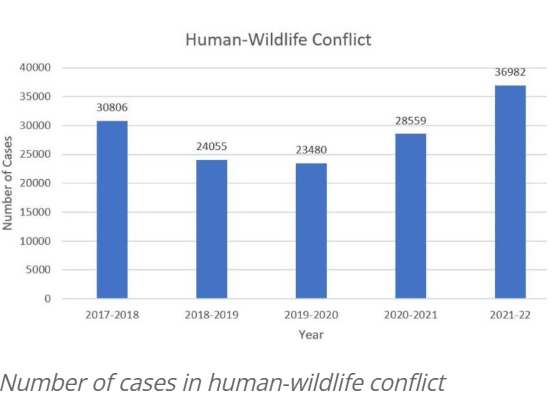Context:
A 40 year old women was killed in leopard attack in Junnar forest of Pune district. This incident marks the seventh death from human-leopard conflict in the Junnar forest division since March and the second in this village.
Relevance:
GS3- Biodiversity and Conservation
Dimensions of the Article:
- Rising Human-Wildlife Interactions in India
- About the Indian Leopard
- Way Forwards to prevent Man – Animal Conflicts
Rising Human-Wildlife Interactions in India:
In India, the increasing occurrence of human-wildlife interactions is undeniable. Given the inevitability of conflicts with wildlife, it’s crucial to seek better solutions beyond reactive capture and relocation, which have often proven unsustainable or even harmful to the animals involved.

About the Indian Leopard:
Scientific Name: Panthera pardus
Overview:
- Leopards, characterized by their elusive and nocturnal nature, exhibit variations in size and color influenced by their habitat.
- Known for their adept climbing skills, they often seek refuge in trees to conceal their prey and avoid competition.
Geographical Distribution:
- Belonging to the cat family, leopards inhabit a diverse range of regions, including Asia, sub-Saharan Africa, Southern Russia, and the Indian subcontinent.
- The Indian leopard, scientifically identified as Panthera pardus fusca, is prominently found across the Indian subcontinent.
Habitat:
Leopards showcase notable adaptability in terms of their habitat preferences and dietary needs. They are commonly spotted in agro-pastoral landscapes, plantations, and in close proximity to human settlements, encompassing both rural and urban areas.
Conservation Status:
- Leopards are classified as ‘Vulnerable’ on the IUCN Red List and are listed under Appendix I of CITES.
- The Wildlife Protection Act of 1972 designates them under Schedule I, acknowledging their need for stringent protection measures.
Population in India:
- According to the ‘Status of Leopards in India, 2018’ report released by the Ministry of Environment, Forest and Climate Change (MoEF&CC), there was a remarkable “60% increase in the population count of leopards in India compared to the 2014 estimates.”
- The ‘Status of Leopards in India, 2022’ report, published by the Union Environment Ministry on February 29, reveals an approximate leopard count of 13,874 in India, marking an increase from the 2018 figure of 12,852.
Associated Concerns:
Man-Animal Conflict:
Leopards in India inhabit a variety of landscapes, ranging from dense forests to urban areas. However, their proximity to human settlements often results in conflicts, as leopards enter villages in search of food or territory, leading to attacks on livestock and occasionally on humans. Such encounters pose significant threats to both leopard populations and human communities.
Poaching:
Moreover, poaching remains a profitable enterprise, with influential individuals anonymously employing locals; it is crucial to identify and hold them accountable.
Climate Change and other Issues:
Climate change exacerbates these challenges by modifying natural habitats and prey availability. Additionally, forest fragmentation, biodiversity loss, and other changes contribute to the stress on leopard populations.
Way Forwards to prevent Man – Animal Conflicts
- Surveillance- Increased vigilance and protection of identified locations using hi-tech surveillance tools like sensors can help in tracking the movement of animals and warn the local population.
- Improvement of habitat- In-situ and ex-situ habitat conservation measures will help in securing animals their survival.
- Re-locating of animal habitats away from residential and commercial centres will serve to minimize animal-man conflict for illegal and self-interested motives
- Awareness Programmes- To create awareness among people and sensitize them about the Do’s and Don’ts in the forest areas to minimize the conflicts between man and animal.
- Training programs– Training to the police offices and local people should be provided for this purpose forest department should frame guidelines.
- Boundary walls- The construction of boundary walls and solar fences around the sensitive areas to prevent the wild animal attacks.
- Technical and financial support- For the development of necessary infrastructure and support facilities for immobilization of problematic animals through tranquilization, their translocation.
- Part of CSR- Safeguarding Tiger corridors, building eco-bridges and such conservation measures can be part of corporate social responsibility.
-Source: The Hindu, The Indian Express




